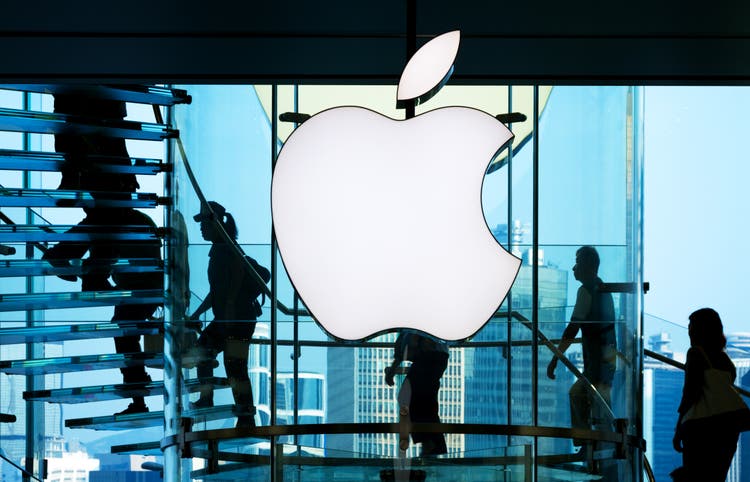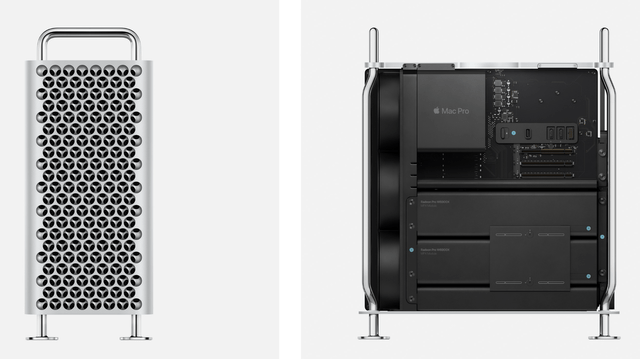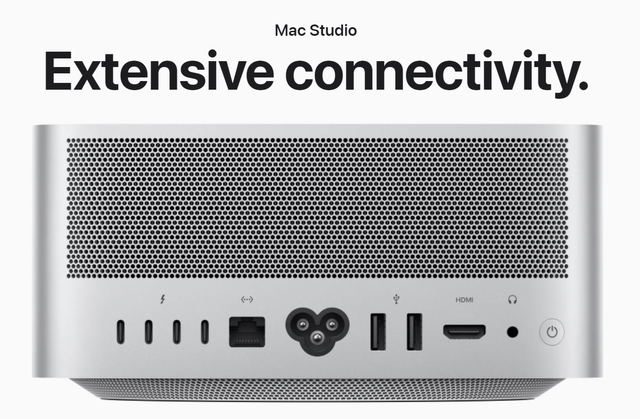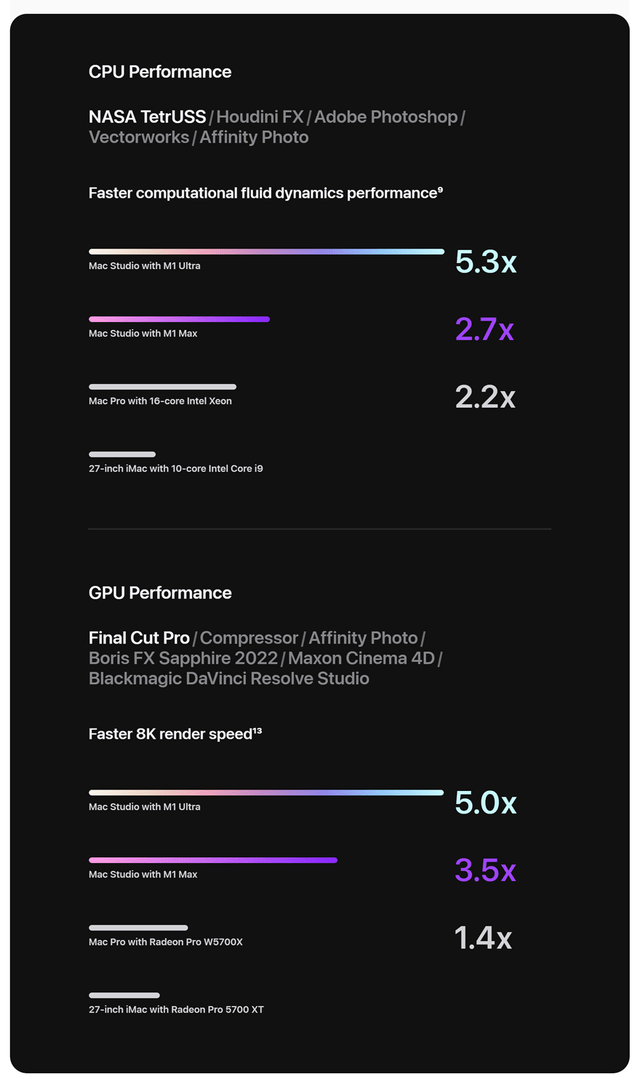Nikada/iStock Unreleased via Getty Images
Apple’s (NASDAQ:AAPL) decision to abandon Intel (INTC) processors in favor of its own custom silicon was a risky gamble that has paid off handsomely. Apple’s decision reinvigorated the Mac product line with high performance ARM architecture processors that are several times more energy efficient than Intel. Mac revenue growth has been reinvigorated as well, with Mac revenue growing by 23% in fiscal 2021. Yet the Mac Pro is still Intel-based, and Apple Silicon Macs are still overly dependent on Intel’s Thunderbolt.
Apple’s venerable Intel-based Mac Pro. Source: Apple.
The Conversion From Intel To Apple Silicon Has Been A Smashing Success
By the time that Apple introduced the first Apple Silicon Macs in November 2020, Intel had become a millstone around the neck of Apple. Mac revenue had been stagnant. It was simply very difficult for Apple to create differentiated personal computers using the same processors that everyone else was using.
Apple Silicon Macs got another boost when the new MacBook Pros were introduced in October 2021. Fiscal 2022 Q1, Mac revenue grew by 25% y/y, a higher growth rate than any other product category that quarter. And Mac went on to grow by 14.6% y/y in Fiscal 2022 Q2, a growth rate second only to Services.
Analysts may not have fully grasped the impact of Apple Silicon. IDC claimed that Mac unit shipments in calendar 2021 Q4 (Apple’s fiscal 2022 Q1) only grew by 8.6% y/y, but that would imply a large ASP increase given the 25% revenue growth. Gartner also claimed that Mac unit sales had only increased by 6.2% y/y.
Apple has been careful to price Apple Silicon Macs comparably to their Intel-based predecessors, so I’m inclined to think that the analysts are simply underestimating the impact of Apple Silicon. This seems to have continued into Apple’s Fiscal Q2. For calendar 2022 Q1, IDC estimated Mac unit shipment growth at just 4.3% y/y and Gartner estimated unit shipment growth at 8.6%.
It appears that analysts still have not accepted the notion that Apple is making serious market share gains in the traditional PC space, but Apple Silicon has made an impact on the tech media. It’s difficult to find a review of an Intel-based laptop that doesn’t compare it to the new MacBook Pro. And when it comes to energy efficiency, there is no comparison.
But Even The Mac Studio Leaves Something To Be Desired In Graphics Performance
I’ve been delighted with the energy efficiency and computational power of my Apple Silicon MacBook Pro, but when I wanted to upgrade my desktop workstation, I passed over the Mac Studio for my own dual Ice Lake Xeon system build with an Nvidia (NVDA) RTX 3090 graphics card.
But no HDMI 2.1. Source: Apple.
The M1 Ultra in the Mac Studio is a clever melding of two M1 Max SOCs. Its CPU processing power is phenomenal, even edging out my dual Xeon system in Geekbench Multicore. But in graphics, Apple’s claim at the launch that it would outperform the 3090 just didn’t pan out.
Numerous reviewers have spotted this, so I’ll just point out one, The Verge:
We ran Geekbench Compute, which tests the power of a system’s GPU, on both the Mac Studio and a gaming PC with an RTX 3090, a Core i9-10900, and 64GB of RAM. And the Mac Studio got… destroyed. It got less than half the score that the RTX 3090 did on that test – not only is it not beating Nvidia’s chip, but it’s not even coming close.
And it doesn’t come close in most other practical use cases or benchmarks. Apple’s internal GPU puts every other iGPU in the PC world to shame, but it just can’t compete with discrete GPUs that are as large as silicon foundries can make.
In addition to the lack of graphics horsepower, there’s another limitation of the Studio which Apple has been a little cagey about, and that’s the HDMI port. Apple doesn’t say in their specs which HDMI version is in the Studio, but it appears to be HDMI 2.0.
The latest generation of graphics cards generally support HDMI 2.1. What’s the difference? HDMI 2.1 supports driving 8K displays at 60 fps. HDMI 2.0 does not. Apple advertises that it can “output” 8K video, but that may simply apply to transcoding within an editing app. You can’t actually watch 8K 60p video or drive an 8K display at 60 fps with Mac Studio’s HDMI port, although there may be an unsupported workaround for Thunderbolt.
Given that almost any PC workstation with a current generation graphics card has HDMI 2.1 built in, I consider the Mac Studio’s lack of support for HDMI 2.1 to be almost unforgivable. 8K is clearly the future, and professional videographers have already migrated to 8K and 12K cameras and 8K displays. My own workstation drives an 8K60p display.
What’s Taking So Long With The Mac Pro?
Which brings us to the long awaited Apple Silicon Mac Pro, that presumably will be free of the shortcomings of the Mac Studio. I was a little disappointed that Apple didn’t preview the new Mac Pro at WWDC. It would have been a logical venue that they’ve used in the past for that purpose.
This conveys to me that Apple is still struggling with what the new Mac Pro should be. I think Apple would like it to be an all-in-one SOC design, perhaps using multiple chiplets.
Current technology has converged on the CPU and GPU being discrete chips in separate packages. Even the most advanced design concepts for supercomputers still make use of this fundamental division of labor.
So, if Apple is to build a truly competitive professional workstation, it probably needs to figure out how to accommodate a discrete GPU in the Mac Pro. Along those lines, Apple also has to decide whether to support third party GPUs.
When Apple debuted the Mac Studio, they announced that the Mac Pro was still on the way (by way of reassurance) and that the M1 Ultra would be the last of the M1 series. To me, this indicates that Apple had realized by that time (March 2022) that the current M1 series would not be suitable for the future Mac Pro.
Future more advanced SOCs in the M2 series can be expected to address the architectural issues I’ve raised: support for much more capable graphics, more advanced display capability, and hopefully, even higher CPU core counts. How Apple decides these issues may still be in doubt within the company.
In the meantime, Apple has to soldier along with Xeon-based Mac Pros, which Apple disparages every chance it gets in favor of Apple Silicon:
Source: Apple.
Apple’s Over-Dependence On Intel’s Thunderbolt
So far, every Apple Silicon Mac has used Thunderbolt as its primary interface to the outside world. But Thunderbolt is proprietary Intel technology, and every Mac Thunderbolt port has an Intel chip sitting behind it.
This is another area where the divorce from Intel is incomplete, and it provides an explanation for the HDMI limitation, not only in the Mac Studio, but also every other Apple Silicon Mac that offers HDMI.
Apple appears to be driving the HDMI video through the Intel Thunderbolt interface chips. Thunderbolt 4 tops out at a data rate (40 Gbit/sec) just shy of what would be required for HDMI 2.1, so Apple can’t support HDMI 2.1 without completely changing the data paths and creating a separate interface for it.
While the limitations of Thunderbolt may be acceptable for M1 series Macs, it clearly would have been a disaster to limit the external interface of the Mac Pro to Thunderbolt. Apple tried that with the cylindrical Mac Pro, and we all know how that worked out.
There may even have been some thought of going that route and marketing what would become the Mac Studio as the new Apple Silicon Mac Pro. I’m sure that once they got the device in front of some focus groups, it was quickly realized that professional users expected a workstation with PCIE expansion capability.
Apple should shift its interface focus from Thunderbolt to PCIE. PCIE is more versatile than Thunderbolt, and PCIE Gen 5 will be faster for x2 lanes and above. Almost every PC interface you can think of, USB, Ethernet, Wi-Fi, and graphics are ultimately driven by PCIE.
Building PCIE into its next generation of Apple Silicon would not only free it from dependence on Intel Thunderbolt, but would set it up to support the kind of Mac Pro that professional users want. This is an area where Apple should go with the flow. All modern x86 processors support PCIE interfaces on chip.
Investor Takeaways
The combination of performance and efficiency demonstrated by Apple Silicon is truly unparalleled, yet I’ve come to realize that Apple will need to do more to win more PC market share.
The incomplete divorce from Intel points to some soft spots in the Apple Silicon approach. It may not be technically feasible to build an internal GPU that is truly competitive with a discrete GPU. But Apple needs to provide that level of performance by some means.
Thunderbolt is a useful interface that’s very convenient and easy to use, but it’s rather constricted compared to PCIE. The bandwidth advantage of PCIE is not going to go away any time in the near future.
If Apple adopts PCIE, then it has a straightforward path to solving its GPU needs and for providing a more capable interface for all of its Mac products. With PCIE, Apple can finally complete its divorce from Intel, and continue to grow market share for Apple Silicon Macs. I remain long Apple and rate it a Hold.








